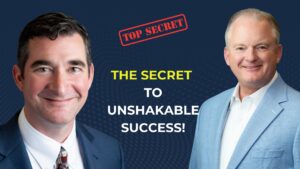How to Create a Defensible Market for Your Business
In a competitive world, creating a defensible market is crucial for long-term success. A defensible market allows you to maintain pricing power, secure recurring revenue, and ensure your business thrives even in challenging times.
In this episode of the $4M Strategies™ podcast, Carl J. Cox, CEO of 40 Strategy and 40 Accounting, speaks with Bill Canady, author of The 80/20 CEO, about the essential elements of building a defensible market. Bill shares a framework that he uses when assessing businesses, breaking it down into four key factors. These insights are invaluable for entrepreneurs, executives, and business leaders looking to create a strong and sustainable market position.
What Is a Defensible Market?
A defensible market is one where your business holds a unique advantage that competitors cannot easily replicate. This creates barriers to entry and allows you to maintain control over pricing, product availability, and customer loyalty.
Bill highlights the importance of targeting the right markets and products to create a business that is not only profitable but also resilient.
The Four Key Elements of a Defensible Market
To build a defensible market, Bill focuses on four critical factors:
- Mission Critical Products
Your product or service must be essential to your customers. If something goes wrong, they need your product to fix it. Without it, their operations could stop entirely.
For example:
- A broken engine part that prevents a machine from running is mission critical.
- A minor decorative component that doesn’t impact functionality is not.
Why it matters:
Being mission critical ensures your product is indispensable, making customers reliant on your offering.
- Severe Service Environments
Products that operate in harsh or demanding conditions tend to wear out over time. This creates a natural replacement cycle, driving recurring revenue.
Examples of severe service products include:
- Industrial machine components that face high wear and tear.
- Specialized equipment used in extreme environments, such as oil rigs or manufacturing plants.
Why it matters:
Recurring demand ensures your business has a steady revenue stream, making growth predictable and sustainable.
- Low-Cost Components with High Impact
Bill emphasizes focusing on products that represent less than 2% of the total cost of the system they are part of but are essential for its operation.
For instance:
- A small, critical screw in a multimillion-dollar extruder machine.
- A key sensor in a complex industrial system.
Why it matters:
When your product is a small percentage of the total cost, customers are less sensitive to price changes, giving you greater pricing power.
- Control Over the Supply Chain
To maintain a defensible market, your product must be difficult to replicate or source elsewhere. This could involve:
- Proprietary manufacturing techniques.
- Strong intellectual property (IP) protections.
- Exclusive access to critical materials or components.
Why it matters:
If customers can only get the product from you, they are more likely to remain loyal and less likely to switch to competitors.
Common Pitfalls to Avoid
Bill also shares the risks of entering bad markets. Even the best leaders cannot overcome the challenges of a poorly chosen market. Instead of trying to transform a bad market, focus on identifying markets that meet these four criteria.
Applying These Principles to Your Business
To create a defensible market, start by evaluating your current offerings:
- Assess Mission Criticality: Is your product indispensable to your customers?
- Evaluate Recurring Revenue Potential: Does your product naturally wear out or require replacement?
- Analyze Cost Sensitivity: Is your product a small but crucial part of a larger system?
- Secure Supply Chain Control: Can your product be sourced or replicated elsewhere?
By answering these questions, you can determine whether your market position is truly defensible or identify areas for improvement.
Why It Matters
Creating a defensible market isn’t just about immediate profitability—it’s about building a sustainable business model that can weather competition and economic uncertainty. As Bill points out, “Bad markets beat good leaders.” The key is to find the right market and dominate it with smart strategies.
Key Takeaways
- Focus on mission-critical products that customers cannot do without.
- Target severe service environments to drive recurring revenue.
- Ensure your product is a low-cost but essential component of a larger system.
- Control the supply chain to maintain exclusivity and protect your market position.
Interested in becoming a podcast sponsor? Let’s Talk!
Listener Feedback:














